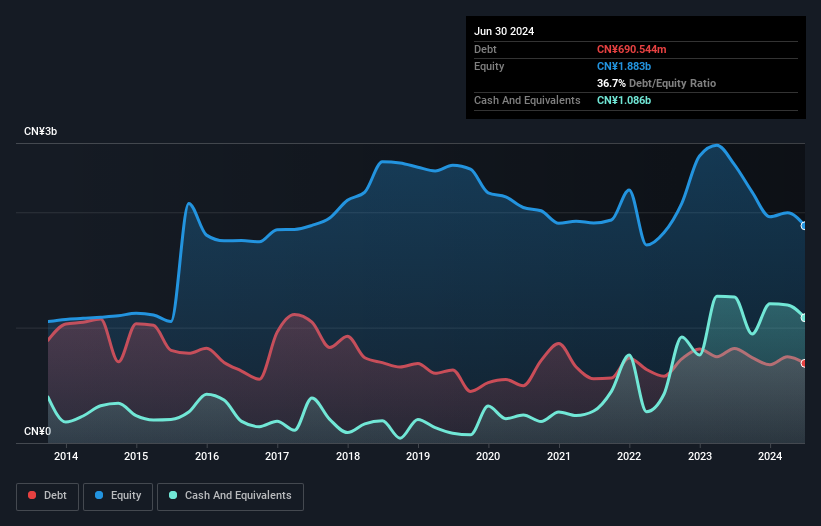- China
- /
- Metals and Mining
- /
- SHSE:603399
Health Check: How Prudently Does Jinzhou Yongshan Lithium (SHSE:603399) Use Debt?
Legendary fund manager Li Lu (who Charlie Munger backed) once said, 'The biggest investment risk is not the volatility of prices, but whether you will suffer a permanent loss of capital.' So it might be obvious that you need to consider debt, when you think about how risky any given stock is, because too much debt can sink a company. We note that Jinzhou Yongshan Lithium Co., Ltd (SHSE:603399) does have debt on its balance sheet. But the more important question is: how much risk is that debt creating?
Why Does Debt Bring Risk?
Debt assists a business until the business has trouble paying it off, either with new capital or with free cash flow. Ultimately, if the company can't fulfill its legal obligations to repay debt, shareholders could walk away with nothing. While that is not too common, we often do see indebted companies permanently diluting shareholders because lenders force them to raise capital at a distressed price. By replacing dilution, though, debt can be an extremely good tool for businesses that need capital to invest in growth at high rates of return. When we think about a company's use of debt, we first look at cash and debt together.
View our latest analysis for Jinzhou Yongshan Lithium
How Much Debt Does Jinzhou Yongshan Lithium Carry?
You can click the graphic below for the historical numbers, but it shows that Jinzhou Yongshan Lithium had CN¥690.5m of debt in June 2024, down from CN¥820.1m, one year before. But it also has CN¥1.09b in cash to offset that, meaning it has CN¥395.1m net cash.

A Look At Jinzhou Yongshan Lithium's Liabilities
According to the last reported balance sheet, Jinzhou Yongshan Lithium had liabilities of CN¥1.42b due within 12 months, and liabilities of CN¥559.8m due beyond 12 months. Offsetting these obligations, it had cash of CN¥1.09b as well as receivables valued at CN¥464.3m due within 12 months. So its liabilities total CN¥429.8m more than the combination of its cash and short-term receivables.
Of course, Jinzhou Yongshan Lithium has a market capitalization of CN¥3.66b, so these liabilities are probably manageable. Having said that, it's clear that we should continue to monitor its balance sheet, lest it change for the worse. While it does have liabilities worth noting, Jinzhou Yongshan Lithium also has more cash than debt, so we're pretty confident it can manage its debt safely. When analysing debt levels, the balance sheet is the obvious place to start. But it is Jinzhou Yongshan Lithium's earnings that will influence how the balance sheet holds up in the future. So if you're keen to discover more about its earnings, it might be worth checking out this graph of its long term earnings trend.
Over 12 months, Jinzhou Yongshan Lithium made a loss at the EBIT level, and saw its revenue drop to CN¥6.7b, which is a fall of 26%. That makes us nervous, to say the least.
So How Risky Is Jinzhou Yongshan Lithium?
By their very nature companies that are losing money are more risky than those with a long history of profitability. And we do note that Jinzhou Yongshan Lithium had an earnings before interest and tax (EBIT) loss, over the last year. And over the same period it saw negative free cash outflow of CN¥93m and booked a CN¥279m accounting loss. With only CN¥395.1m on the balance sheet, it would appear that its going to need to raise capital again soon. Overall, we'd say the stock is a bit risky, and we're usually very cautious until we see positive free cash flow. For riskier companies like Jinzhou Yongshan Lithium I always like to keep an eye on the long term profit and revenue trends. Fortunately, you can click to see our interactive graph of its profit, revenue, and operating cashflow.
If you're interested in investing in businesses that can grow profits without the burden of debt, then check out this free list of growing businesses that have net cash on the balance sheet.
New: Manage All Your Stock Portfolios in One Place
We've created the ultimate portfolio companion for stock investors, and it's free.
• Connect an unlimited number of Portfolios and see your total in one currency
• Be alerted to new Warning Signs or Risks via email or mobile
• Track the Fair Value of your stocks
Have feedback on this article? Concerned about the content? Get in touch with us directly. Alternatively, email editorial-team (at) simplywallst.com.
This article by Simply Wall St is general in nature. We provide commentary based on historical data and analyst forecasts only using an unbiased methodology and our articles are not intended to be financial advice. It does not constitute a recommendation to buy or sell any stock, and does not take account of your objectives, or your financial situation. We aim to bring you long-term focused analysis driven by fundamental data. Note that our analysis may not factor in the latest price-sensitive company announcements or qualitative material. Simply Wall St has no position in any stocks mentioned.
About SHSE:603399
Jinzhou Yongshan Lithium
Engages in research and development, production, and sale of battery-grade lithium carbonate and battery-grade lithium hydroxide in China.
Mediocre balance sheet and slightly overvalued.
Similar Companies
Market Insights
Community Narratives


Recently Updated Narratives


MINISO's fair value is projected at 26.69 with an anticipated PE ratio shift of 20x


The Quiet Giant That Became AI’s Power Grid


Nova Ljubljanska Banka d.d will expect a 11.2% revenue boost driving future growth
Popular Narratives


The company that turned a verb into a global necessity and basically runs the modern internet, digital ads, smartphones, maps, and AI.


MicroVision will explode future revenue by 380.37% with a vision towards success



